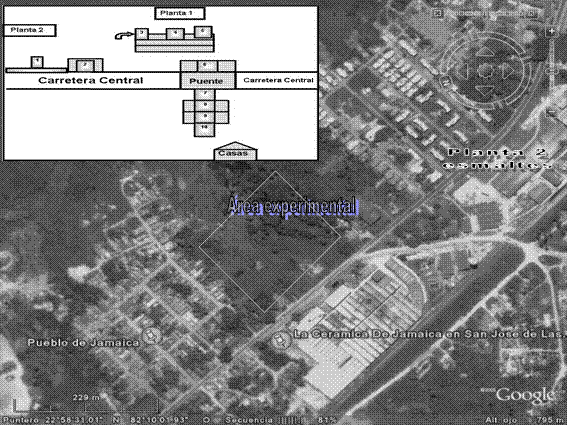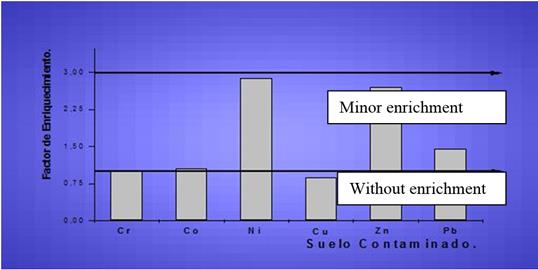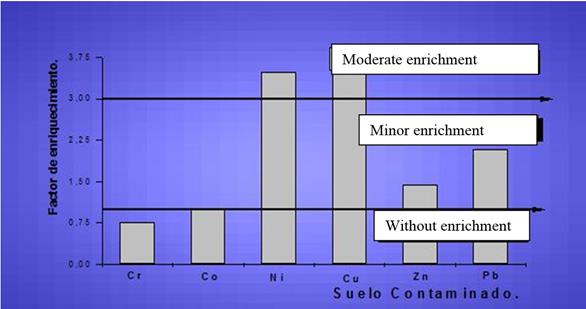INTRODUCTION
The soil is a necessary condition for the existence of life, although it does not possess a true recognition of its ecological value and its relation to human health. The international scientific community and authorities worldwide have raised the need to establish indicators of soil quality to conserve or improve the productivity of the land while protecting environmental and food quality as well as human health. The development of certain industrial activities may constitute a moderate risk of environmental contamination. Such risk is not only due to atmospheric emissions, but also, to bad management of its waste or poor storage of raw materials and products, which can cause leaks of components that accumulate in the soil (Valdés et al., 2015).
These trace elements are food toxics and their negative effects on health are manifested in the long term. The analysis of urban soils is carried out by different analytical techniques. In the specific case of the determination of heavy metals, a method that has shown great efficiency and adequate limits of detection in the study of urban soils is Dispersive X-ray Fluorescence in non-destructive nuclear technical energy. It allows multi-element analysis of large volumes of samples, independently of the physical state in which it is found and at a relatively low cost (Echevarría, 2010). In the framework of the alliances between the Agrarian University of Havana and the Environmental Analysis Laboratory of the Institute of Nuclear Technology (InSTEC), the contamination levels of the agricultural soils surrounding Ceramic Company of San José de las Lajas are determined. In that place, located in Mayabeque Province, vegetables of nutritional importance are cultivated and they are reported as heavy metal-accumulating species that do that in their own tissues (Echevarría, 2010). For this reason, it is proposed as objective: to evaluate pollution conditions in soils with agricultural use that receive industrial waste.
METHODS
Geographical Location of the Study Area
Soil samples were taken in a production area adjacent to the dumping area of Empresa Cerámica Blanca "Adalberto Vidal". The potential danger of producing vegetables in these lands has been noticed for five years, due to their high contents of heavy metals, which are dangerous for human and animal health (Alarcón et al., 2015) (Figure 1).
Preparation of Samples and Certified Reference Materials (MRC)
The analysis were performed in the Analytical Laboratory of the Nuclear Physics Department of InSTEC. The soil samples were taken manually to a depth of 0 - 20 cm, neglecting the most superficial layer. They were placed in polyethylene bags and like certified reference materials dried in an oven at 60 ° C until constant weight. Five subsamples were collected per plot in the form of a crosshead; the subsamples taken at the vertices of the rectangle were obtained with an approximate separation of 1 m from the boundary of the plot. The subsamples of each plot were homogenized to constitute a single sample. Stone, plants, etc. were manually removed and they were screened at 125 μm and then mixed with cellulose in a 4: 1 ratio. After homogenized, "infinitely thick" tablets were made, pressed at 15 tons. The irradiation of the tablets was carried out for 6h of live time, and the dead time was, in all cases, below 1%. The following certified reference materials (MRC) were used: IAEA Soil-5 "SoilSample", IAEA Soil-7 "SoilSample", IAEA-356 "Polluted Marine Sediment", IAEA SL-1 "Lake Sediment" (all supplied by the IAEA), BCSS-1 "Marine Sediment" of the National Research Council of Canada, BCR-2 "Basalt Columbia River", SGR -1 "Green RiverShale" and MAG-1 "Marine Sediment" from the US Geological Survey .US. (PNO.09, 2007). The intensity of the characteristic radiation of each element in each sample was obtained from processing the spectra in WinAXIL program and it was carried out under the premise that the composition of the samples and that of the reference materials is approximately same.
Determination of Heavy Metals
The determination of heavy metal concentration was performed with a high-resolution Si detector (Li) for X-ray spectrometry and a radioisotope source of 238Pu of low energy photons, by means of Energy X-ray Dispersive Fluorescence. It was used an aluminum excitation chamber with a collimator for radiation with characteristics of 1 cm in diameter and height of the adjustable sample holder. The minimum source-detector distance was 18 mm. The direct radioisotope excitation was supplied by AMERSHAND, which has a half-life of 87 years and an emission energy (U-L) of 12-17 KeV with a scheme of disintegration α. All spectra were processed with WinAxil code, version 4.5.2.
Quality of Analysis
To verify the quality of the quantification analysis, McFarell criterion was used (Quevauviller and Marrier, 1995) according to Echevarría (2010). On the basis of this criterion, there are three categories: if SR ≤ 25%, the method is considered excellent for the analysis; if 25% ≤ SR ≤ 50%, it is considered acceptable and for values of SR> 50%, the method is considered unacceptable for quantification. The analysis of MRA IAEA-Soil-7 (Pszonicki, 1984) according to Echevarría (2010), is presented in Table 1. All heavy metals except for Cr and Ni are excellent. In the case of the two metals mentioned above, their high SR is based on the low statistics of counting, because in natural soils their concentrations are very small.
TABLE 1 Analysis by FRX of the MRC Soil - 7. The concentrations ± their Standard Deviation are expressed in mg.kg-1, except indicated
| Metal | Calculated Value | Reported Value | SR (%) |
|---|---|---|---|
| Cr | 59.9 ± 17.3 | 60.00 | 48 |
| Fe (%) | 2.13 ± 0.1 | 2.57 | 18 |
| Co | 9.1 ± 1 | 8.90 | 25 |
| Ni | 23.3 ± 5.0 | 26.00 | 48 |
| Cu | 10.1 ± 0.3 | 11.00 | 15 |
| Zn | 103.6±4.6 | 104.00 | 9 |
| Pb | 56.1±2.8 | 60.00 | 3 |
Toxicological and Heavy Metals Pollution Evaluations in Soils
According to the Dutch Guide of soil toxicity (Figure 2), the actions to be taken in case of contamination of soils and surface waters are established.
From this guide, authors derive two standard values that guarantee the quality of the soils: reference value and intervention value (Swartjes, 1999).

FIGURE 2 Scheme showing the relationship between reference value and intervention value according to the Dutch soil toxicity guide.
Both standards are based on potential risks to the ecosystem and to man. The reference value refers to a risk to the ecosystem, while the intervention value also includes a potential risk to human health.
To normalize the approximation and obtain the real concentration of the element, they were standardized to a background material and a dimensionless enrichment factor (EF) was defined as:
Where: X is the concentration of the potentially enriched metal and Y is the concentration of the reference metal used. The validity of this enrichment factor varies with the values used for the regional background levels.
An enrichment factor greater than unity means the existence of a non-natural contribution in the determined concentration of an element. Table 2 presents the classification of the degree of enrichment depending on the FE value (Birch, 2003 cited by Echevarría, 2010).
TABLE 2 Degree of Enrichment
| FE | Degree of Enrichment |
|---|---|
| > 50 | Extremely severe enrichment |
| 25 - 50 | Very severe enrichment |
| 10 - 25 | Severe enrichment |
| 5 - 10 | Moderate to severe enrichment |
| 3 - 5 | Moderate enrichment |
| 1 - 3 | Minor enrichment |
| < 1 | Without enrichment |
For this work, iron was used as the reference metal for normalization, because it is a major element of the earth's crust, which is hardly influenced by anthropogenic sources due to the high natural levels of this element (Pérez, 2016).
The pollution index (IP) and the integral pollution index (IPI) were determined, whose equations appear below and according to them, the soils are classified as low (IPI ≤ 1.0, IP ≤ 1.0), moderately contaminated (1.0 <IPI ≤ 2.0, 1.0 <IP ≤ 3.0) or highly contaminated (IPI> 2.0, IP> 3.0), based on the criterion of Martínez et al.(2008):
n- heavy metals number.
The enrichment index (EI) was found from an average of the division of the element concentration within the permissible level. The permissible level originates from the threshold concentrations of the element in soils around which crops produced are considered dangerous for human health (Valdés et al., 2015):
If the IE is greater than 1 on average, the concentrations of the elements are greater than the permissible levels, which is a sign of risk for agricultural activity in the study area.
RESULTS AND DISCUSSION
Content of Elements in the Ground. Valuations
The concentration levels of heavy metals determined in the soil samples under study are shown in Table 3.
TABLE 3 Concentration of heavy metals in the studied soils in the agricultural areas of San José de las Lajas Municipality
| Cr ± std | Co ± std | Ni ± std | Cu ± std | Zn ± std | Pb ± std | Fe(%)± std | |
|---|---|---|---|---|---|---|---|
| Decontaminated | 118± 42 | 15± 4 | 84± 29 | 364± 98 | 117± 40 | 90± 27 | 4.54± 1 |
| Contaminated | 154± 38 | 20± 38 | 317± 25 | 421± 32 | 415± 24 | 173± 31 | 5.95± 1 |
| VR a | 100 | 9 | 35 | 36 | 140 | 85 | |
| VI a | 380 | 240 | 210 | 190 | 720 | 530 | |
| LSP b | 100 | 50 | 75 | 100 | 300 | 100 | |
| CT c | 100 | 25 | 74 | 55 | 70 | 13 | 5 |
| a- Reference Values (VR) and Intervention Values (VI) of Dutch Norms. | |||||||
| b- Admissible Upper Limits in soils | |||||||
| c- Values reported for the earth's crust | |||||||
As expected, the concentration of trace elements in the samples of contaminated soil is much higher than that determined in decontaminated soil, with the exception of cobalt, where the difference is only 5 units. The values of contaminated soil are higher than the reference values proposed in the Dutch Standards of Soils Swartjes (1999). In the case of nickel and copper, the value exceeds the limit of intervention of these standards, which classifies said soil as moderately contaminated in Cr, Co, Zn and Pb and in need of urgent remediation due to Ni and Cu concentrations. In turn, these values, with the exception of cobalt, are much higher than those reported for the earth's crust and those proposed as Admissible Upper Limits (Kabata-Pendias, 2010).
The values found are directly related to the waste from the Ceramic Company "Adalberto Vidal". Although many authors recognize vehicle emissions as an important factor in the contribution of heavy metals to the soils (Mohamed and Asem, 2018), it should be noted that the production area where the studies are carried out and the company characterized as pollutant, are separated from a road of constant movement of vehicles (Alarcón et al., 2015).
The normalization to iron as a reference metal showed that there is a minor enrichment, except for Cu, which does not present enrichment, in the elements of interest studied (Figure 3).
The normalization methods depend completely on the chosen background; in this case, samples of soil from Playa Baracoa were used as background. Place away from industries and urban traffic, which was intended to obtain a soil as less contaminated as possible. A very simple way to check if the bottom is not really contaminated is to recalculate the Enrichment Factor with a bottom that is actually recognized as such (Raimundo et al., 2018). Therefore, the previous calculations were repeated, but this time using as baseline Havana baseline (Echevarría, 2010).
The new Enrichment Factor calculations show differences with respect to Ni and Cu, which now happen to have a Moderate Enrichment. The most significant case is Cu, which, in the previous calculation, was classified as Not Enriched; this is related to the concentrations of Cu, present in the sample chosen as background, which has higher Cu values than those reported for Havana (Figure 4).
The comparison of the Enrichment Factor using the baseline proposed by Echevarría (2010) as background, shows similar results, which validates the choice of the bottom. The only notable difference comes with respect to Cu, which goes from the category of No Enrichment (lowest category) to Moderate Enrichment (scale three of five possible); of which Cu contamination could be suspected in the soils taken as the bottom.
The most enriched metals according to the calculations are Ni, Cu and Pb. These elements are found in concentrations much higher than those reported for the average of Cuban agricultural soils (Orroño, 2002; Núñez et al., 2007; Pérez López et al., 2012; Olivares et al., 2013; Muñiz et al., 2014; Pérez, 2016). Table 4 also shows the comparison with the acceptable average levels for the production of healthy foods and the average levels considered phytotoxic, both values are also much lower than those obtained in the study soils (Fadigas et al., 2006).
TABLE 4 Data of three elements obtained compared with acceptable average levels for the production of healthy foods and average levels considered phytotoxic
| Metal | Conc. | Average levels acceptable for the production of healthy food * | Average levels considered phytotoxic * | Levels means in Cuban agricultural soils ** |
|---|---|---|---|---|
| Ni | 317 | 110 | 300 | 38 |
| Cu | 421 | 23 | 100 | 28,6 |
| Pb | 173 | 20 | 20 | 8,2 |
* (Kabata-Pendias, 2010).
**(Muñiz et al., 2014).
Table 5 shows IP, IPI and IE values. As it can be seen, in almost all the points of the area, according to the calculated values of IP, for the values taken as background, there is an average level of pollution with the exception of Ni and Zn metals. Meanwhile, the IP calculated with respect to the baseline of Havana City (Echevarría, 2010), results in high contamination, also in the case of Cu. The values reported for IPI reflect a high level of pollution in all cases, in which IE gives more than unity, which qualifies the soils as unsuitable for agricultural use.
TABLE 5 Results of the evaluated indicators
| IP | IPI | IE | ||||||
|---|---|---|---|---|---|---|---|---|
| Cr | Co | Ni | Cu | Zn | Pb | |||
| Bottom | 1,30 | 1,37 | 3,77 | 1,16 | 3,54 | 1,91 | 2,17 | 2,29 |
| Habana (baseline)* | 1,02 | 1,38 | 4,70 | 4,69 | 1,95 | 2,81 | 2,75 | |
* Línea de Base de Ciudad Habana (Echevarría, 2010).
CONCLUSIONS
The values of the contaminated soil were higher than the reference values proposed in the Dutch Land Standards.
The soil under study was classified as moderately contaminated in Cr, Co, Zn and Pb and in need of urgent remediation due to the concentrations of Ni and Cu, being much higher than those reported for the earth's crust and those proposed as Admissible Upper Limits.
The normalization methods used to identify anomalous concentrations of heavy metals in the analyzed soil, the Enrichment Factor, classified it as Very Strongly Contaminated, which is the last and most serious classification that such standardization has.











 texto em
texto em 





